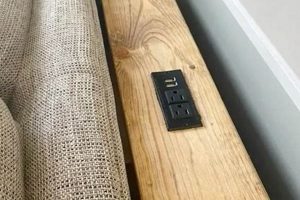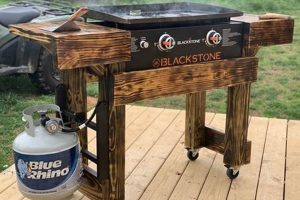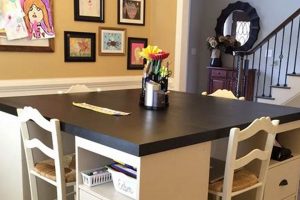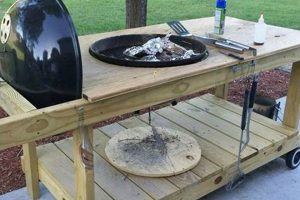A homemade, rustic-style table intended for dining is the central focus. These tables are often constructed using readily available lumber and simple joinery techniques. A common example is a tabletop made of reclaimed wood planks supported by a painted or stained base, typically featuring sturdy legs.
The appeal of constructing such furniture stems from several factors. It allows for significant cost savings compared to purchasing commercially manufactured pieces. Individuals can customize dimensions and finishes to perfectly suit their dining space and aesthetic preferences. Historically, farmhouse furniture reflects a practical and unpretentious design philosophy, emphasizing durability and functionality; contemporary do-it-yourself versions continue this tradition while offering opportunities for personalization.
This article will explore material selection, essential tools, construction methods, and finishing techniques pertinent to building a durable and aesthetically pleasing example. Subsequent sections will delve into detailed instructions, common challenges, and strategies for achieving a professional-looking result.
Essential Guidance for Construction
The following recommendations aim to optimize the building process and enhance the longevity of the finished product. Careful consideration of these points will mitigate potential errors and ensure a satisfactory outcome.
Tip 1: Lumber Selection. Prioritize kiln-dried hardwood. Softwoods, while less expensive, are more susceptible to dents and scratches. Kiln-drying reduces warping and twisting after assembly. For example, maple or oak are preferable to pine for the tabletop.
Tip 2: Precise Measurements. Accurate measurements are crucial. Employ a high-quality measuring tape and double-check all dimensions before cutting any material. Discrepancies accumulate and can compromise the structural integrity of the piece.
Tip 3: Secure Joinery. Utilize appropriate joinery techniques. Pocket hole screws, mortise and tenon joints, or dowel joints provide robust connections. Insufficiently secured joints will lead to instability over time.
Tip 4: Adequate Sanding. Thorough sanding is imperative. Start with a coarse grit sandpaper (e.g., 80-grit) to remove imperfections, then progressively use finer grits (e.g., 120-grit, 220-grit) to achieve a smooth surface. An uneven surface will negatively affect the finish.
Tip 5: Proper Finishing. Select a durable finish suitable for dining surfaces. Polyurethane, lacquer, or varnish offer protection against spills and scratches. Apply multiple thin coats, allowing sufficient drying time between each application.
Tip 6: Hardware Considerations. Choose high-quality hardware. Inferior screws and bolts are prone to stripping and breakage. Opt for screws with deep threads and bolts with robust heads. For example, use stainless steel screws for exterior applications or to prevent rust.
Tip 7: Consider Expansion and Contraction. Wood expands and contracts with changes in humidity. When attaching the tabletop to the base, allow for this movement by using slotted mounting brackets or elongated screw holes. This prevents cracking or warping.
Adhering to these recommendations will contribute significantly to the creation of a functional and durable dining table. These considerations will enhance the project’s overall success.
The subsequent sections will provide detailed instructions on addressing common challenges encountered during the build process, including specific techniques for overcoming warping and achieving a professional finish.
1. Rustic Wood Selection
Rustic wood selection is integral to crafting a dining table exhibiting a farmhouse aesthetic. The choice of lumber dictates not only the visual character but also the overall durability and longevity of the finished piece. Careful consideration of wood species, grain patterns, and pre-existing imperfections is paramount.
- Wood Species and Visual Appeal
Different wood species inherently possess distinct visual qualities. Reclaimed pine, for example, frequently exhibits nail holes, knots, and weathering, contributing to a more pronounced rustic appearance. Conversely, hardwoods such as oak or maple can be distressed to mimic the aged look, while providing greater resistance to wear and tear. The chosen species directly impacts the table’s perceived character.
- Grain Pattern and Aesthetic Consistency
The grain pattern of the wood significantly influences the overall aesthetic. Wider grain patterns, often found in older lumber, can amplify the rustic feel. It is critical to ensure consistency in grain pattern across all components of the tabletop to avoid a disjointed appearance. Mismatched grain patterns detract from the cohesiveness of the final product.
- Imperfections and Character Enhancement
Natural imperfections such as knots, checks (small cracks), and insect damage are often considered desirable characteristics in rustic wood. These features add authenticity and tell a story of the wood’s past. However, it is important to assess the structural integrity of pieces with significant imperfections to ensure they do not compromise the table’s stability. Carefully selected and strategically placed imperfections can enhance the rustic charm.
- Sourcing and Environmental Considerations
Rustic wood can be sourced from various locations, including salvage yards, demolition sites, and specialty lumber retailers. Reclaimed lumber offers an environmentally responsible option, repurposing materials that would otherwise be discarded. Responsible sourcing practices help minimize environmental impact. Choosing FSC-certified wood from sustainable forests is an alternative if reclaimed lumber is unavailable.
The selection of rustic wood directly shapes the final product and influences the visual narrative. Careful consideration of wood species, grain pattern, pre-existing imperfections, and sourcing practices ensures that the finished table not only embodies the farmhouse aesthetic but also possesses the necessary structural integrity for long-term use. These elements ultimately contribute to the creation of a bespoke dining piece.
2. Sturdy Leg Design
The structural integrity of any dining table rests heavily upon the design and construction of its legs. This is especially critical in the context of a self-assembled farmhouse-style table, where variations in material and construction techniques can significantly impact stability and longevity.
- Leg Material and Load-Bearing Capacity
The choice of leg material directly affects the table’s ability to support weight. Hardwoods such as oak, maple, or walnut offer superior strength compared to softwoods like pine. The dimensions of the leg (thickness and width) must be adequate to distribute the load evenly. Undersized legs can lead to wobbling or eventual collapse, particularly under heavy use. An example includes a dining table intended to seat eight individuals, requiring proportionally thicker and more robust legs than a smaller table designed for four.
- Joinery Methods and Structural Stability
The method used to attach the legs to the table’s apron or directly to the tabletop significantly influences the table’s stability. Common joinery techniques include mortise and tenon, dowel joints, and metal brackets. Mortise and tenon joints, when properly executed, provide exceptional strength and resistance to racking forces. Screws alone are generally insufficient for providing long-term structural integrity, especially with the expansion and contraction of wood due to humidity changes. Using metal brackets, a cost-effective solution, should be paired with high-quality screws of appropriate length to penetrate deeply into both the leg and the apron.
- Leg Placement and Weight Distribution
The positioning of the legs relative to the tabletop’s edges and the overall table dimensions influences weight distribution and stability. Legs placed too close to the center of the table can result in excessive flexing of the tabletop, particularly with heavier materials. Legs that are splayed outward at an angle offer increased stability against tipping. The size of the tabletop, the planned weight it will bear, and the type of joinery all must be considered when determining leg placement.
- Design Aesthetics and Functional Considerations
Beyond structural requirements, leg design contributes significantly to the overall aesthetic of the table. Turned legs, trestle legs, and straight, tapered legs each evoke a distinct style. However, aesthetic choices must not compromise functionality. Intricately carved legs, while visually appealing, may be structurally weaker than simpler designs. Furthermore, leg placement should allow comfortable seating arrangements, avoiding interference with chairs or legroom. Therefore, both visual taste and practical design is required.
The intersection of material selection, joinery techniques, leg placement, and aesthetic considerations dictates the success of the leg design and subsequently influences the overall stability and visual appeal of the finished farmhouse-style dining table. Prioritizing these elements contributes to a durable and aesthetically pleasing piece.
3. Tabletop Joinery Technique
Tabletop joinery technique represents a critical determinant of the structural integrity and aesthetic quality of a self-constructed dining table. For a farmhouse-style table, where a rustic and often substantial appearance is desired, the choice of joinery method directly influences the table’s ability to withstand daily use and resist warping or cracking over time. Insufficiently robust joinery will lead to instability and premature failure, thereby undermining the intended purpose and longevity of the piece. A poorly joined tabletop, for instance, may exhibit gaps between boards, uneven surfaces, or even complete separation under stress. The careful selection and execution of an appropriate joinery technique are therefore paramount.
Several joinery methods are commonly employed in the construction of dining table tops. These include, but are not limited to, tongue and groove, butt joints reinforced with dowels or biscuits, and breadboard ends. Tongue and groove joints create a mechanical interlock between adjacent boards, providing increased resistance to cupping and warping. Butt joints, while simpler to execute, necessitate the use of supplementary fasteners, such as dowels or biscuits, to achieve adequate strength. Breadboard ends, perpendicular pieces attached to the ends of the tabletop, serve to constrain the wood’s natural tendency to expand and contract across its width, thereby mitigating warping. A farmhouse table built with wide planks joined solely with screws is likely to develop significant gaps and warping within a relatively short period, whereas a table utilizing breadboard ends and properly executed tongue and groove joints is far more likely to maintain its structural integrity for many years.
In summary, the proper application of a robust tabletop joinery technique is not merely an aesthetic consideration but a fundamental requirement for constructing a durable and functional dining table. The selection of the appropriate technique depends on factors such as the width and thickness of the tabletop boards, the desired aesthetic, and the available tools and skill level. A thorough understanding of these factors is essential to ensure the long-term performance and visual appeal of the finished piece. The selection of high-quality materials and the careful execution of the chosen technique are directly correlated with the overall success of the build.
4. Finish Durability
The longevity and aesthetic appeal of a homemade, rustic-style dining table are intrinsically linked to the durability of its finish. A properly applied and resilient finish protects the wood from moisture, stains, scratches, and other forms of damage, thereby extending the table’s lifespan and preserving its intended appearance. Neglecting this aspect can lead to premature wear, requiring frequent refinishing or even complete replacement of the tabletop.
- Resistance to Liquid Penetration
Dining tables are inherently exposed to spills of various liquids, including water, oil, wine, and acidic substances. A durable finish forms a barrier that prevents these liquids from penetrating the wood fibers, thus preventing staining, swelling, and warping. Polyurethane and epoxy finishes are known for their excellent liquid resistance, whereas oil-based finishes provide less robust protection against prolonged exposure to moisture. A tabletop coated with an inadequate finish, upon contact with a spilled beverage, may exhibit permanent staining or blistering, necessitating costly repairs.
- Protection Against Abrasion and Scratches
Daily use of a dining table involves contact with utensils, plates, and other objects that can cause scratches and abrasions. A durable finish provides a protective layer that absorbs these impacts, minimizing the risk of damage to the underlying wood. Harder finishes, such as conversion varnish, offer superior scratch resistance compared to softer finishes like wax. A tabletop finished with a low-durability coating may quickly accumulate scratches and surface imperfections, diminishing its aesthetic appeal.
- UV Resistance and Color Stability
Exposure to ultraviolet (UV) light can cause certain finishes to fade, yellow, or otherwise discolor over time. A durable finish incorporating UV inhibitors helps to protect the wood and maintain its original color. This is particularly important for light-colored woods or tables placed in areas with significant sunlight exposure. A table lacking UV protection may exhibit noticeable color changes after prolonged exposure to sunlight, altering its intended visual character.
- Chemical Resistance to Cleaning Agents
Regular cleaning is necessary to maintain the hygiene and appearance of a dining table. A durable finish must be resistant to the chemicals found in common cleaning agents, preventing damage such as dulling, softening, or dissolving. Acid-cured finishes and catalyzed lacquers offer excellent resistance to a wide range of chemicals. Using harsh cleaning products on a table with a sensitive finish may result in irreversible damage, compromising its protective qualities.
The selection and application of a finish that prioritizes durability are vital to ensuring the long-term functionality and aesthetic value of a self-assembled, rustic-style dining table. The attributes of a durable finishresistance to liquid penetration, abrasion, UV light, and cleaning chemicalsdirectly contribute to the table’s ability to withstand the rigors of daily use and maintain its intended appearance over an extended period. Choosing the correct finish and following application instructions are essential steps.
5. Size Customization
Size customization is a fundamental aspect of creating a dining table, particularly within the framework of the do-it-yourself approach. This capacity to tailor dimensions directly addresses the cause of spatial limitations or unique functional requirements. The effects of improper sizing range from inadequate seating capacity to inefficient use of available space. Its importance as a component is that each component must work well within constraints. For example, a standard, commercially available table may not fit optimally in a small dining area or accommodate a large family. Do-it-yourself construction provides the means to address these specific needs.
Achieving accurate dimensions requires careful measurement of the intended location, consideration of seating capacity, and an understanding of ergonomic principles. An individual constructing a table for a narrow dining room might opt for a long, narrow design to maximize seating while minimizing obstruction. Conversely, a larger space might accommodate a wider, more expansive table. The ability to customize extends beyond simple length and width, encompassing table height to accommodate specific chair heights or physical needs. Customization includes adjustable-height tables, to accommodate ADA (Americans with Disability Act) standards.
The flexibility inherent in the self-build approach allows the creation of furniture that perfectly integrates with existing spaces and meets particular functional demands. This level of personalization is a primary advantage over purchasing pre-fabricated items. Overcoming potential challenges associated with size customization involves meticulous planning, precise measurements, and an understanding of basic woodworking principles. By prioritizing these aspects, individuals can create a unique and functional dining table that seamlessly complements the dining environment.
6. Cost Effectiveness
The economic advantage associated with constructing a rustic-style dining table stems from the mitigation of several costs inherent in retail furniture. Manufacturing overhead, retailer markup, and shipping expenses contribute significantly to the price of commercially available tables. By undertaking the construction process, these intermediary costs are effectively eliminated, resulting in a lower overall expenditure. The primary costs incurred are raw materials (lumber, fasteners, finish), tool investment (if necessary), and time.
Significant savings are often realized through the utilization of reclaimed materials. Reclaimed lumber, sourced from deconstructed buildings or salvaged timbers, can be acquired at a fraction of the price of new lumber. Furthermore, imperfections inherent in reclaimed wood often enhance the rustic aesthetic sought in a farmhouse-style table, providing both economic and aesthetic benefits. As an example, a dining table constructed from reclaimed barn wood might cost approximately half the price of a similar table purchased from a furniture retailer. This presupposes access to reclaimed materials and the requisite skills to process and incorporate them effectively. Additional cost savings accrue from the capacity to precisely tailor the table’s dimensions and features to specific needs, precluding the need to pay for features not desired or modifications to a pre-existing piece.
In summation, the cost-effectiveness of constructing a dining table is attributable to the elimination of retail overhead, the potential utilization of lower-cost reclaimed materials, and the ability to customize the design to minimize material waste and avoid unnecessary features. The financial benefits must, however, be weighed against the investment of time and labor required for the construction process, as well as the potential for errors that could result in additional costs. Skilled craftsmanship significantly contributes to the success of the project.
7. Farmhouse Aesthetic
The farmhouse aesthetic serves as a guiding principle in the design and construction of dining tables. It emphasizes functionality, simplicity, and a connection to rural traditions. This aesthetic dictates design choices ranging from material selection to finishing techniques, all intended to evoke a sense of warmth, comfort, and rustic charm within the dining space. The construction embodies these principles.
- Natural Material Emphasis
The farmhouse aesthetic inherently values the use of natural materials, particularly wood, in its raw or minimally processed state. Reclaimed lumber, rough-hewn planks, and naturally finished surfaces are hallmarks of this style. A dining table built with these materials connects the space to the outdoors, creating a visual texture and tactility that synthetic materials cannot replicate. For example, using a tabletop constructed from salvaged barn wood with its original nail holes and weathered patina directly reinforces the farmhouse aesthetic.
- Simple, Functional Design
Farmhouse furniture typically eschews elaborate ornamentation in favor of clean lines and straightforward functionality. The focus is on practicality and durability, prioritizing usability over purely decorative elements. A dining table adhering to this principle might feature a simple trestle base or straight, untapered legs. Its design prioritizes seating capacity and stability, avoiding complex carvings or embellishments that detract from its primary purpose. Designs that support the table’s structure and purpose are emphasized.
- Distressed and Aged Finishes
The farmhouse aesthetic embraces imperfection and the passage of time. Distressed finishes, characterized by worn edges, faded paint, or intentional imperfections, contribute to the overall sense of age and authenticity. Techniques such as sanding edges, dry brushing paint, or applying antique glazes are commonly employed to achieve this look. These finishes lend character and history to the table, suggesting a piece that has been used and loved for generations. A clear example of this, consider painting the table and then sanding back the edges and corners to reveal the wood beneath, creating a worn, vintage appearance.
- Neutral Color Palette
The farmhouse aesthetic favors a neutral color palette, incorporating tones of white, cream, gray, and natural wood. These colors create a sense of calm and tranquility, reinforcing the connection to nature. While pops of color may be incorporated through accessories or textiles, the primary furniture pieces typically adhere to this neutral scheme. A dining table painted a soft, creamy white with a lightly distressed finish exemplifies this principle, providing a versatile backdrop for various dining arrangements. Colors complement the overall design.
These facets of the farmhouse aesthetic directly influence the choices made during the construction of a dining table. The materials selected, the design implemented, the finishing techniques employed, and the color palette adopted all contribute to the table’s ability to embody the desired aesthetic. The result should integrate cohesively within a farmhouse-style dining room.
Frequently Asked Questions
The following addresses prevalent inquiries and clarifies common misunderstandings regarding constructing a rustic-style dining table. These answers aim to provide practical guidance and inform decision-making throughout the building process.
Question 1: What is the most appropriate wood type for constructing a durable tabletop?
Hardwoods such as oak, maple, and walnut provide superior durability and resistance to denting and scratching compared to softwoods like pine or fir. While softwoods are less expensive, their susceptibility to damage necessitates increased maintenance and may reduce the table’s lifespan.
Question 2: Is specialized woodworking equipment required for this project?
While advanced equipment can expedite the process and improve precision, it is possible to construct a functional dining table with basic tools. A circular saw, drill, sander, and measuring instruments are essential. More complex joinery techniques may necessitate specialized tools such as a router or biscuit joiner, but alternative methods can often be substituted.
Question 3: How can wood warping be prevented after construction?
Preventing wood warping involves selecting kiln-dried lumber, which has a reduced moisture content. Employing appropriate joinery techniques, such as breadboard ends or tongue-and-groove joints, further constrains the wood’s natural tendency to move. Applying a sealant or finish to all surfaces, including the underside of the tabletop, helps to equalize moisture absorption and minimize warping.
Question 4: What type of finish is most suitable for a dining table surface?
A durable and food-safe finish is paramount. Polyurethane, varnish, or lacquer provide a protective barrier against spills, scratches, and heat. Ensure the chosen finish is specifically formulated for interior use and compliant with relevant safety standards. Multiple thin coats are preferable to a single thick coat for optimal durability and appearance.
Question 5: How can a rustic, distressed appearance be achieved?
Distressing techniques include strategically sanding edges and corners to reveal underlying wood, applying layers of paint and then selectively removing them, and using tools to create simulated dents and scratches. The key is to achieve a natural, authentic appearance rather than an overly artificial one. Experimentation on scrap wood is recommended before applying these techniques to the finished table.
Question 6: What are the key considerations for ensuring structural stability?
Structural stability relies on several factors, including proper leg placement, robust joinery, and the selection of appropriate hardware. Legs should be positioned to distribute weight evenly and securely attached to the tabletop using methods such as mortise-and-tenon joints or heavy-duty metal brackets. Screws and bolts should be of sufficient length and quality to prevent stripping or breakage.
In summary, successful construction hinges upon careful material selection, employing appropriate techniques, and adhering to safety precautions. Knowledge reduces risks.
The subsequent section will provide detailed, step-by-step instructions for assembling a basic dining table, incorporating the recommendations outlined above.
Conclusion
The preceding exploration of a “diy farmhouse dining table” has underscored critical considerations for successful construction. Material selection, joinery techniques, finishing processes, and design choices have been detailed to inform a robust and aesthetically pleasing outcome. Understanding these factors is essential for achieving a durable and functional piece of furniture.
The culmination of this knowledge empowers individuals to create a personalized dining centerpiece, reflecting both skill and aesthetic vision. Further exploration into advanced joinery or finishing techniques will undoubtedly enhance the quality and longevity of future projects. The benefits of this kind of work is real and has great value to users.







